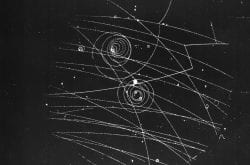Social

CERN70: Where the Web was born…
20 August 2024
Tim Berners-Lee wrote a proposal in 1989 for an information management system called the World Wide Web
Source || Part 15 of the CERN70 Series
In 1989, Tim Berners-Lee, a young scientist working at CERN, wrote a proposal for an information management system based on the Internet. At ...
CERN70: Green light for LEP
31 July 2024
Herwig Schopper was Director-General of CERN from 1981 to 1988, during which time the Large Electron Positron collider was approved and constructed
Source || Part 14 of the CERN70 Series
The Large Electron Positron collider (LEP) project was first presented to the CERN Council in ...
CERN70: The end of the alphabet
11 July 2024
Carlo Rubbia’s name is closely related to the discovery of the W and Z particles at CERN
Source || Part 13 of the CERN70 Series
In 1983, CERN reached the end of the alphabet when the Laboratory announced the discovery of the long-sought W and Z particles. The announcement was so ...
CERN70: A two-stage rocket
27 June 2024
Ted Wilson was involved in the design of the Super Proton Synchrotron (SPS) and played a leading role in its commissioning.
Source || Part 12 of the CERN70 Series
In the early 1960s, when the Proton Synchrotron (PS) had just come into service, the scientific community was already ...
CERN70: A gargantuan discovery
13 June 2024
Violette Brisson played an active part in the discovery of neutral currents; she was head of the Gargamelle group at the Laboratory of the École Polytechnique in Paris
Source || Part 11 of the CERN70 Series
It was the first great discovery to be made at CERN. On 19 July 1973, ...
CERN70: The world’s first hadron collider
29 May 2024
Kjell Johnsen was the Intersecting Storage Rings (ISR) project leader when the accelerator was built
Source || Part 10 of the CERN70 Series
On 27 January 1971, the world’s first collisions between two beams of protons occurred in CERN’s Intersecting Storage Rings (ISR). By the ...
CERN70: An electronic revolution
16 May 2024
Georges Charpak received the 1992 Nobel Prize in Physics for his 1968 invention of the multi-wire proportional chamber, which revolutionised particle detection
Source || Part 9 of the CERN70 Series
Progress in fundamental particle physics research often relies on developing ever more ...
CERN70: The nucleus as a laboratory
2 May 2024
Helge Ravn was part of the ISOLDE group from the beginning
When ISOLDE began operations at CERN in 1967, it was unique in the world
Source || Part 8 of the CERN70 Series
When the Isotope Separator On-Line (ISOLDE) began operations at the Synchrocyclotron (SC) in 1967, it was unique in ...
CERN70: Cutting-edge computing
17 April 2024
Paolo Zanella came to the CERN computing group in 1962, just a few years after the first computer had arrived
Source || Part 7 of the CERN70 Series
CERN’s first computer, a huge vacuum-tube Ferranti Mercury, was installed in 1958. It represented the first stage in the evolution of ...
CERN70: Tracing particles
26 March 2024